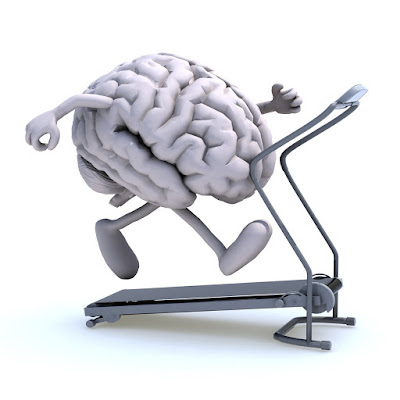
1. Switch Your Hands
If you are right-handed, try using your left hand to do things
like brushing your teeth, eating, and using your computer mouse. Using your non-dominant hand results in increased brain
activity. This can be very hard at first which is why it gives your
brain a good workout.
2. Do Things the Hard Way
The most obvious way to do things the hard way is to stop relying
on technology. Use your brain instead of your Smartphone for basic mental skills
like spelling and math. Impress your friends by memorizing their phone numbers
(gasp!). Turn off the GPS and learn to read a map and use your innate
sense of direction to find your way around instead.
3. Challenge Yourself with Mastery
Learning something new stimulates brain activity. But as soon as you master it, the mental benefit stops because
your brain becomes more efficient at the activity. The only way to continue to stimulate your brain is to give
it new challenges and stay out of your comfort zone. So once you master something, challenge yourself with the next
level of difficulty or learn a related skill. For this reason, pursuits like learning languages, playing musical
instruments, or chess are ideal brain exercises because there is always more
to learn.
4. Try New Things
Do things you’ve never done before. Travel somewhere you’ve never been. Check out an unfamiliar ethnic cuisine. Try a hobby that is totally out of character for you. If you are a couch potato, sign up for a dance class. If you are athletic, try needlepoint. Novel experiences trigger the release of dopamine, the
“motivation” neurotransmitter. It also stimulates the creation of new neurons.
5. Simultaneously Use All Your Senses
Try activities that simultaneously engage all your senses. Travel, camping, and gardening are high on Dr.
Katz’s list of activities that utilize all your senses in new
ways. One of his favorite examples is shopping at a farmer’s market
where you can look, touch, sniff and taste the produce. Being sociable and talking with the farmer who grew your food
provides additional brain stimulation.
6. Take New Routes
On a routine commute, your brain is on autopilot and gets very
little stimulation. But taking an unfamiliar route activates the cortex and
hippocampus. It has been said that Bill Gates would drive a different route on
the way home from work each day to stimulate his brain, and look where that got
him! There’s no need to stick to driving. You can take new routes when walking, biking, or ride public
transportation.
7. Read Books Aloud
Take turns reading and listening to a book with your significant
other, a friend, or a child. If that’s not feasible, alternate reading with listening to
audiobooks. This engages the imagination in a different way. One of the earliest demonstrations of brain imaging clearly showed
three distinct brain regions lighting up when the same word was read,
spoken, or heard.
8. Do Things Upside Down or Backwards
No worries, you don’t have to stand on your head for this one. Stimulate your brain by looking at things upside down. An easy one to start with is wearing your watch upside down. This forces your brain to really think every time you glance at
your watch. You can also hang clocks or calendars upside down. When you get used to that, you can graduate to using your phone,
or whatever else you can imagine, upside down. Or you can channel your inner Leonardo da Vinci and try mastering
the art of writing backward, known as mirror writing.
9. Do Chores with Your Eyes Closed
When taking a shower, washing your hair, or sorting laundry, try
doing it with your eyes closed. This will force your brain to use new neural pathways. bviously, don’t do anything with your eyes closed that could put
you or others in danger.
10. Start Meditating
It’s estimated that over 18 million Americans meditate. Mayo Clinic, Harvard, and the National Institutes of Health extol
its many benefits. Major corporations like Google, General Mills, Target, Apple,
Nike, Procter & Gamble and AOL offer structured meditation programs for
executives and encourage employees at all levels to do it. The US military finds meditation helps troops deal with stress,
improves their cognitive resilience, and increases their ability to focus. But is meditation really exercising your mind? Here’s why meditation makes it onto our list of top brain
exercises.


No comments